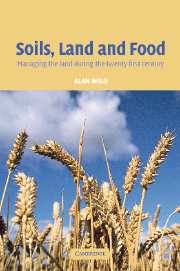Book contents
- Frontmatter
- Contents
- Preface
- Acknowledgements
- 1 Managing land for food production in the twenty-first century: an outline
- 2 Natural resources for sustainable land management
- 3 The development of agriculture and systems of land management
- 4 Maintaining and improving soil fertility
- 5 Land degradation and its control
- 6 Raising yields: use of fertilizers
- 7 Raising yields: water for rainfed crops and irrigation
- 8 Managing change of land use: seven examples
- 9 Increasing and sustaining agricultural production
- 10 Increasing agricultural production: the examples of Africa, India and China
- 11 Prospects and uncertainties
- References
- Index
10 - Increasing agricultural production: the examples of Africa, India and China
Published online by Cambridge University Press: 05 June 2012
- Frontmatter
- Contents
- Preface
- Acknowledgements
- 1 Managing land for food production in the twenty-first century: an outline
- 2 Natural resources for sustainable land management
- 3 The development of agriculture and systems of land management
- 4 Maintaining and improving soil fertility
- 5 Land degradation and its control
- 6 Raising yields: use of fertilizers
- 7 Raising yields: water for rainfed crops and irrigation
- 8 Managing change of land use: seven examples
- 9 Increasing and sustaining agricultural production
- 10 Increasing agricultural production: the examples of Africa, India and China
- 11 Prospects and uncertainties
- References
- Index
Summary
INTRODUCTION
Chapter 9 considered how agricultural production could be increased in two groups of developing countries by extending the area of cultivation and by increasing crop yields. Inevitably, generalizations were made that would be grossly misleading if applied to individual countries, regions within countries, village communities or individual farmers.
This chapter extends the discussion to two countries — China and India — and to the continent of Africa except for Egypt and South Africa. All three have large, increasing populations, large rural sectors and expanding urban populations. These conditions create opportunities for a farmer to sell surplus produce and so pay for services (health care, education, etc.), agricultural inputs and manufactured goods. If marketing his produce is profitable he will have the incentive to raise his production. Whether farmers in the two countries and in Africa can do this by extending the cultivated area or by raising crop yields is the main theme of this chapter. The conclusions reached indicate a ladder of development, with larger yields becoming progressively more important.
AFRICA: THE RECENT PAST AND FUTURE PROSPECTS
In this chapter Africa* refers to all African countries except Egypt and the Republic of South Africa. Egypt is omitted because of its large crop yields, almost the whole of its arable crop production depending on irrigation. South Africa is omitted because of its advanced state of industrial development.
- Type
- Chapter
- Information
- Soils, Land and FoodManaging the Land during the Twenty-First Century, pp. 183 - 206Publisher: Cambridge University PressPrint publication year: 2003



